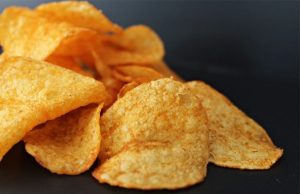What is E 100 additive?
The food additive E 100 – curcumin, belongs to the category of natural chalcone colours. E100(i)-curcumin or E100(ii)-turmeric can be found in foods.
How is curcumin obtained?
Curcumin is obtained by solvent extraction of turmeric, i.e. from ground rhizomes of Curcuma longa L. stems. To obtain concentrated curcumin powder, the extract is purified by crystallisation. The product consists mainly of curcumin; i.e., the colouring principle [1,7-bis(4-hydroxy-3-methoxyphenyl)hepta-1,6- dien-3, 5-dione] and the two desmethoxy derivatives in varying proportions. Small amounts of oils and resins naturally occurring in turmeric may be present. Curcumin is also used as an aluminium lake; the aluminium content is less than 30%. Curcumin can only be extracted in the following solvents: ethyl acetate, acetone, carbon dioxide, dichloromethane, n-butanol, methanol, ethanol, hexane, 2-propanol.[i]
Both curcumin and turmeric are obtained from the roots and stems of the Curcuma longa and Curcuma domestica plants. Curcumin is the crude extract, while turmeric is the purified compound.
Which foods contain the food additive E 100?
Curcumin imparts a yellow-orange colour and is allowed to be used in various types of food.
The food additive E100 can be found in the following products:
- margarine as well as in other fat emulsions and non-emulsified fats,
- wine-based flavoured drinks (bitter soda, bitter vino),
- jams, marmalades and jellies, sweetened chestnut puree and other similar fruit preparations exclusively low-calorie products,
- to make sausages, pates and soups,
- dried potato granules and flakes,
- non-alcoholic beverages in the dose in candied fruits and vegetables,
- canned fruit,
- confectionery, ornaments and quilts,
- fine bakery products (biscuits, waffles, etc.)
- aromatic melted cheese,
- desserts, including flavoured dairy products,
- sauces, condiments, salsas, etc.
- mustard,
- fish and shellfish paste,
- semi-prepared crustaceans,
– salmon substitutes,
- smoked fish,
- fish roe,
- non-heat-treated processed meat,
- membranes, coatings and meat decorations,
- supe,
- snacks, miscellaneous.
The additive can be added in liquid and solid food supplements/dietary supplements, in similar meat and fish products based on vegetable proteins, in aromatic wines or aromatic wine-based drinks as well as in fruit wines, cider, pear brandy, etc.[ii],[iii]
What else can curcumin and turmeric be used for?
In India, turmeric powder, a strong yellow pigment, is used to dye fabrics. The specific colour of monks’ robes in Buddhist temples is given by this pigment.
In gastronomy, turmeric powder can be incorporated into spice mixes (curries), used as such for various culinary preparations or drinks – for example, turmeric latte , incorporated into herbal combinations used for teas. It can also be used to colour Easter eggs with natural pigments, alongside beetroot, cranberry juice, onion leaves, spinach, red cabbage, paprika or red wine.
Turmeric powder, which contains curcumin, is also recommended for cosmetic use. The compounds in its composition can prevent or remedy problems such as hair loss or dandruff, fade dark circles and brighten the complexion, even out hyperpigmented skin, act as an adjuvant in the treatment of acne due to its anti-inflammatory and antibacterial properties, prevent premature ageing, gently exfoliate the skin, stimulate the natural production of collagen in the skin, have an antioxidant role.
Turmeric can be eaten fresh or pickled, and for its qualities as a natural food colouring, it is used in products such as mustard or crisps.[iv]
Are there any side effects from consuming the food additive E 100?
In general, the additive poses no health risk to the consumer if used in moderate doses.
As for the accumulation of curcumin in the body, animal studies have shown that it is rapidly metabolised and excreted (mainly via faeces). Human studies have also shown that it is unlikely to accumulate in the body after ingestion, even at substantial intakes of up to 12,000 mg/person, equivalent to 200 mg/kg bw for a 60 kg person.
Curcumin has been studied for genotoxicity in a set of short-term genetic toxicity tests.
In in vitro cell studies, it was reported that curcumin does not induce chromosomal damage in Chinese hamster ovary cells. The results of several genotoxicity studies on turmeric or curcumin concluded that there is no mutagenic activity in bacteria treated with turmeric preparations containing up to 85% curcumin.[v]
Some studies have shown that compared to Western populations, people in Southeast Asian countries have a reduced risk of colon, gastrointestinal, prostate, breast, ovarian and other cancers. It is thought that this is probably due to the presence of natural compounds such as curcumin, garlic, ginger, chilli, etc. in their daily diet. Other studies have shown that curcumin exerts chemopreventive activity against breast, prostate, colon and lung cancers.
Curcumin may protect cells as it exerts antioxidant and anti-inflammatory effects through different mechanisms. Oxidative stress plays a clear role in the pathogenesis of many diseases. Curcumin has been found to be a bifunctional antioxidant that can directly stop free radicals and/or multiply various cytoprotective and antioxidant proteins.[vi]
What are the characteristics of E 100 additive?
The additive E 100 has the following synonyms: CI Natural Yellow 3, Turmeric Yellow, Diferoylmethane, Turmeric or Curcumin.
Curcumin occurs as a crystalline, orange-yellow powder, insoluble in water but soluble in hot ethyl alcohol, glacial acetic acid and concentrated sulphuric acid. The yellow extract is fluorescent. Turmeric powder is characterised not only as a colouring agent but also as a spice (curry powder) and is widely used in traditional Indian and other cuisines.
Curcumin dye, in extract or crystalline powder form, is stable to heating but not very lightfast (it discolours in the presence of oxygen). It has a melting temperature of 183o C. The additive must have a total dye content of 90%.
| Chemical name | I. 1,7-bis(4-hydroxy-3-methoxyphenyl)hepta-1,6-dien-3,5-dione
II. 1-(4-hydroxyphenyl)-7-(4-hydroxy-3-methoxy-phenyl)hepta-1,6-dien 3,5-dione III. 1,7-bis(4-hydroxyphenyl)hepta-1,6-dien-3,5-dione |
| Chemical formula | I. C21 H20 O6 II. C20 H18 O5 III. C19 H16 O4 |
| Molecular weight | I. 368.39 II. 338.39 III. 308.39 |
| Composition | Contains not less than 90 % total colouring matters |
| Melting range | 179°C – 182°C |
| Purity
Residual solvents
Not more than 50 mg/kg, singly or in combination |
Ethyl acetate
Acetone n-butanol Methanol Ethanol Hexan 2-Propanol |
| Dichloromethane | Not more than 10 mg/kg |
| Arsen | Not more than 3 mg/kg |
| Plumb | Not more than 10 mg/kg |
| Mercury | Not more than 1 mg/kg |
| Cadmium | Not more than 1 mg/kg |
Maximum daily intake/body: The maximum daily intake for human consumption is up to 1 mg/kg body – curcumin and 0,3 mg/kg body – turmeric.
Intake dose in food: 100 – 200 mg/l, 100 – 500 mg/kg.
Description contraindications: This additive is permitted in baby food within the prescribed limits.
Why is it necessary to use E 100 additive?
The use of the additive E 100 is necessary for colouring certain foodstuffs, and at the same time flavouring them.
Turmeric is used in mustard to restore the mustard’s spicy taste. The colouring agent curcumin, as well as turning some foods yellow to make them more appetising, helps make them easier to digest. The need for its use is that the additive colours foods where the colour has been destroyed during processing or storage. At the same time, the colour is also added for its seasoning qualities.
Conclusions and Legislative Regulations E 100
In some Southeast Asian countries, curcumin is an integral part of medicine and phytotherapy, and is frequently used to treat various disorders (biliary, liver, rheumatism, inflammation, sinusitis, menstrual disorders, etc.) In some countries, curcumin is used as an antiseptic, analgesic, anti-inflammatory, antimalarial and insect repellent. [vii]
Specifications for curcumin have been defined in Directive 2008/128/EC, Regulation 231/2018 and by JECFA (JECFA, 2006). It is specified that the purity should not be less than 90% of the total colouring matters. From the definition, it can be assumed that the remaining 10% may be small amounts of naturally occurring oils and resins in turmeric, but this is never explicitly stated.5
Author: dr.ing. Ancuta Fulvia Manolache
Bibliographic references
[i] Commission Regulation (EU) No 231/2012 of 9 March 2012 laying down specifications for food additives listed in Annexes II and III to Regulation (EC) No 1333/2008 of the European Parliament and of the Council
[ii] Elena Orănescu, Food Additives-necessity and risk, SemnE Publishing House, 2005, Bucharest
[iii] Commission Regulation (EU) No 1129/2011 of 11 November 2011 amending Annex II to Regulation (EC) No 1333/2008 of the European Parliament and of the Council by establishing a Union list of food additives
[iv]https://good-routine.com/blogs/the-good-place/totul-despre-curcumin-ce-este-cum-se-foloseste-si-ce-beneficii-aduce-sanatatii
[v] Scientific opinion Scientific Opinion on the re-evaluation of curcumin (E 100) as a food additive1 EFSA Panel on Food Additives and Nutrient Sources added to Food (ANS)2, 3 European Food Safety Authority (EFSA), Parma, Italy, EFSA Journal 2010; 8(9):1679
[vi] Ramin Rezaee, Amir Abbas Momtazi, Alireza Monemi, Amirhossein Sahebkar, Curcumin: A potentially powerful tool to reverse cisplatin-induced toxicity, Pharmacological Research, Volume 117, 2017, Pages 218-227, ISSN 1043-6618, https://doi.org/10.1016/j.phrs.2016.12.037.
[vii] https://koaha.org/wiki/E100_(food_additive)#cite_note-9
9 https://pixabay.com/ro/photos/antiinflamator-curcuma-longa-743044/
10 https://pixabay.com/ro/photos/chipsuri-gust%c4%83ri-crocant-ron%c8%9b%c4%83ie-448737/


